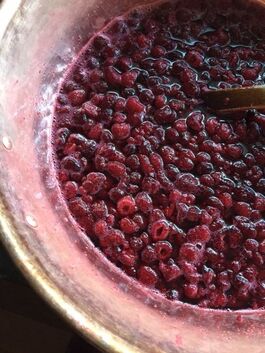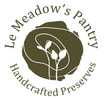 Little Bird’s Nest Cookies Posted on January 15, 2015 Life is always a little sweeter when you’re baking cookies. These beauties have a rich buttery texture and are simple to make. They are all about the butter, use a high quality butter and your favourite jam. 1/2 cup (1 stick) unsalted butter, softened 1/3 cup pure cane sugar 1 egg yolk, lightly beaten 1 teaspoon pure vanilla extract 1 1/4 cups four, ( I used a gluten free mixed and it worked perfectly) pinch of salt Your favourite Le Meadow's Pantry jam or marmalade for filling 1- Preheat oven to 325 degree. Beat together butter and sugar with an electric mixer until fluffy, about 3 minutes. Add egg yolk and vanilla and mix well. 2- Add flour and salt, and mix until just combined. Refrigerate dough for 2 hours. 3- Roll dough into 1-inch balls and space 1 inch apart on baking sheets lined with parchment paper. 4- Press down center of each ball with your thumb. Bake for 10 minutes. Remove from oven; press down center again. Return to oven and bake until golden brown, about 10 minutes. 5- Let cool slightly on sheets. Fill each center with jam. Recipe adapted from Martha Stewart Holiday Cookies
1 Comment
We have had a week of amazing sunshine. To celebrate, dandelion flowers have put on their best colours and are gleaming under clear sky. Dandelion jelly or cramaillote originated in France. Each spring, thousands of dandelions are turned into a golden jelly and are sold at farmer’s market around the country. Dandelion jelly has a rich amber colour with a pleasant taste reminiscent of honey. We don’t need to add any additional flavour to complement the cramaillote, dandelion flowers bring enough character and depth on their own. Dandelion jelly is delicious on a thick slice of rustic potato bread with fresh butter. It also pairs well with goat’s cheeses, soft or hard. While gathering our sun hats and wicker basket to harvest the dandelion flowers, we shall not forget to bring a bottle of freshly made soda with a handcrafted fruit syrup. Orange and Mint Soda Here’s my favourite recipe to a perfect picnic. Orange and Mint Syrup 3-4 large oranges ~ I used Cara Cara, Blood orange or Mandarin would be delicious 2 cups cane sugar 2 cups water 4 tablespoons lemon juice ~ I used 3 tablespoons Meyer lemon and 1 tablespoon lemon 3 sprigs fresh mint Directions: 1. Scrub and zest the oranges. Juice them to equal 2 cups juice. Remove any seeds. 2. In a non reactive large saucepan, place the orange zest and their juice, sugar, water, and lemon juice. Bring to a boil over medium-high heat, reduce the heat, cover, and cook for 20 minutes. 3. Remove from the heat, add mint and infuse for 2 hours. 4. Pour the mixture through a sieve, jelly bag or double layers of cheesecloth into a mixing bowl. (An old t-shirt also works well) 5. Pour the mixture into a jar or bottle and let cool.Keeps in airtight container in the fridge for 10 days and 6 months in the freezer. To use: Two tablespoons mixed in a large glass of bubbly water, chilled or over ice. The Meyer lemon is famous for its juicy, lovely sweet orange-lemon flavourful pulp and incomparable perfume. Rounder than conventional lemon, it has a smooth, thin yellow rind that deepens to orange-yellow as it ripens and it is almost seedless. Preserving Meyer Lemons in Salt Ingredients:
Interesting facts about Meyer Lemon: The fruits expert David Karp tells us that the Meyer lemon (C.x meyeri) was introduced to the United States by another plant explorer, Frank Meyer who discovered the tree growing in pots near Peking in 1908. At that time, lemons were indigenous to India and exotic and scarce in China. Recently a researcher at the University of California at Riverside have determined that the Meyer lemon is a hybrid and that its female parent is almost certainly a sweet orange, and the male a lemon or citron. Every part of the lemon can be use in cuisine. The fragrant skin contains valuable oils that add flavours to drinks, and every kind of dessert. A meyer lemon is different from a regular lemon. If you are using a Meyer lemon you will use it first for it’s perfume, sweetness and subtlety of it. Yet, when you taste it, you may want to add a touch of regular lemon to give it a little more depth. The Meyer lemon’s complex, almost floral flavour and aroma combine happily with grapefruit, honey, lemon, lime, orange, vanilla, thyme, bay leaf and mint. Meyer lemons are usually grown in California but are becoming more widely available. They are perishable and are not in the market for long during the winter months. The beauty of preserving Meyer lemons is that it gives you a way to enjoy them year-round. Preserved lemons are common in Moroccan dishes but their complex, bright flavour and aroma enliven all kinds of soups, stews, salads and drinks. Rhubarb compote is one of the great classics. When the rhubarb is cook long enough to soften, but not too long to turn into purée, the flavours blend harmoniously while the natural acidity of the fruit fades away. The compote should have some pieces left with a dark pink hue.To make the compote you will need:
Dishes where you can use Rhubarb Compote Ricotta cheesecake with rhubarb compote With a spoon straight from the jar Vanilla yogurt , honey and rhubarb compote Apple and rhubarb compote crisp Rhubarb, strawberry and mint cobbler. Rhubarb compote, caramel and walnuts Rhubarb compote and crème fraîche The scarlet rhubarb with its large wavy-edged leaves is a vegetable, though it is usually eaten as a fruit. Wild rhubarb is native to Asia and rhubarb root has remained a prized medicinal herb for thousands of years. Rhubarb is one of the first vegetables to sprout in the spring bringing the traditional rhubarb pie, but it was not until the early 1800s that rhubarb recipes began to appear in cookbooks. Only the stalks are eaten. The leaves have been associated with cases of poisoning due to their high concentration of oxalic acid, and must not be eaten. |
AuthorGeneviève marmalade and jam maker at Le Meadow's Pantry, Vancouver BC Archives
June 2024
Categories |
Copyright © 2024

 RSS Feed
RSS Feed